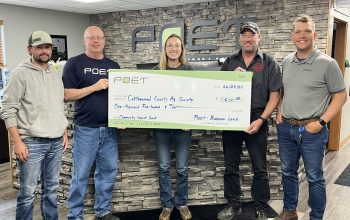Christmas has come and gone. The festive packages that once sat beneath the twinkling tree have all been opened. We’ve all given wonderful gifts to family and friends, but local resident Melody Amonson, without a doubt, has given the best gift of all…and to complete strangers. It didn’t come from a store or through the mail. It didn’t even come in shiny wrapping paper with a pretty bow. Instead, it came from a desire to help others. For years, she has literally been giving them the gift of life by donating blood, platelets, and now this year, plasma with Coronavirus antibodies.
Amonson’s journey to donating began back in 1958 when she was only an infant. That’s when her eight-year-old brother, Harlen, was battling Hodgkin's lymphoma. Treatment for the disease was relatively unknown so his parents decided to take him to Rochester. The doctors there said he needed a blood transfusion, but there was one problem – he had the rarest type of blood, AB-. As a result, family and friends were asked to donate blood for the procedure. They did, but sadly, Harlen still passed away that same year. Melody never got the chance to know him, or donate her own blood for his procedure, but the overall experience would one day inspire her to be a 13-gallon blood donor as well as able to save lives with plasma donations during a world-wide pandemic.
In 2007, she was contacted by Lois Barnes to donate blood at a local drive, and that’s when the events of 1958 came flooding back to her.
“I felt the desire to help others, just as others had helped my brother, explained Amonson. “Lois is a saint because of her work in organizing many, many local blood drives at the United Church of Christ,” she added.
That was Amonson’s first experience with blood donation. Since she also has the same rare blood type her brother had, AB-, she was contacted to continue giving. That gave her an even stronger desire to help and continues to donate on a regular basis.
In 2017, Amonson was approached by the blood center to donate platelets. Platelets are a highly valued blood product because of its use in treating cancer patients. It takes about three hours to donate the platelets because the machine removes your blood, takes the platelets out and then returns the blood to your body.
“Once again, because of the use for cancer patients, I felt motivated to share. I am confident that my brother’s disease would be fully treatable with complete healing in today’s world,” said Amonson.
Then came 2020 and the onset of the world pandemic known as COVID-19. Unfortunately, Amonson contracted the virus on June 17. The use of convalescent plasma was just being researched and found to be a viable treatment for those hospitalized with Coronavirus. When she learned that AB- blood type was a universal donor for plasma, she took the opportunity to make something positive come out of the experience of having the virus.
“If there was even a chance that my plasma could help someone survive I wanted to donate,” she said.
On July 15 (you have to be 14 days free of COVID symptoms), Amonson went in to give her first plasma donation. It only took an hour out of her day to possibly save someone else’s life…or at least make COVID less traumatic for someone else. She described the process involved: After check-in at the blood center a short questionnaire is completed and vitals are taken including blood pressure, temperature, and iron level (taking vitamins and eating red meat helps to meet this requirement.) Once this is completed successfully you are taken to a chair to prepare your arm for donation.
“It is a simple poke in the arm, not painful but I don’t watch,” Amonson admitted.
During the donation your blood is withdrawn into a machine while you squeeze a ball every three to five seconds. Repeatedly, the plasma is withdrawn and your blood is returned to your body. Following the donation you are released to the canteen area for a few minutes and then free to go.
Amonson has donated convalescent plasma 10 times since July, with the most recent being on Christmas Eve in Fort Dodge in honor of Nick Mersch and his lifelong practice of giving blood. Donations can be given weekly for four weeks and then a month break, or it can be given every other week with a break in between donations.
Amonson said she would encourage all those who can to make a donation of blood, platelets, or plasma.
“What a relatively painless and easy way to help save the lives of others. Practice the golden rule – You never know when it might be someone you love in need of a donation,” she said.
Testing for Coronavirus antibodies is done during each donation so you will know when antigens are no longer present in your body as protection from the virus.
If you would like more information about giving Convalescent plasma, go to https://www.lifeservebloodcenter.org/. All of the plasma collected is used to help save lives in local Iowa hospitals.
“I’m often asked if I get paid for donating and the answer is No. There are some places in larger cities that will pay for plasma but it is primarily used for research. Although I know this too is important, I would much rather donate to save lives,” concluded Amonson.


